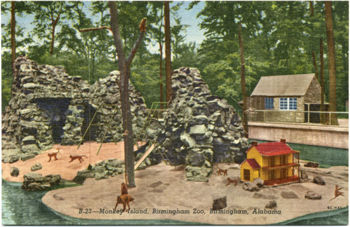Monkey Island: Difference between revisions
No edit summary |
(RIP, Monkey Island.) |
||
| Line 4: | Line 4: | ||
Labor to construct the exhibit was donated by local unions and materials, such as slag for concrete aggregate, were donated by industries. The exhibit was built to resemble an island with rocky outcrops and was surrounded by a shallow pool of water. The interior of the structure is a heated room covered in glazed tiles that could be hosed down every evening. A tunnel connects the room to a building north of the exhibit. | Labor to construct the exhibit was donated by local unions and materials, such as slag for concrete aggregate, were donated by industries. The exhibit was built to resemble an island with rocky outcrops and was surrounded by a shallow pool of water. The interior of the structure is a heated room covered in glazed tiles that could be hosed down every evening. A tunnel connects the room to a building north of the exhibit. | ||
In later years the exhibit was reconfigured as a habitat for alligators and snapping turtles, and later for waterfowl. | In later years the exhibit was reconfigured as a habitat for alligators and snapping turtles, and later for waterfowl. On [[September 25]]-[[September 26|26]], [[2009]], the zoo held a special event as they began dismantling the exhibit and gave visitors an opportunity to receive a piece of the rocks that made the outcrops. | ||
==References== | ==References== | ||
| Line 11: | Line 11: | ||
[[Category:Birmingham Zoo]] | [[Category:Birmingham Zoo]] | ||
[[Category:1955 buildings]] | [[Category:1955 buildings]] | ||
[[Category:Demolished buildings]] | |||
Revision as of 12:01, 23 September 2009
Monkey Island was the first animal exhibit constructed for the Birmingham Zoo at Lane Park. It opened on April 2, 1955 and was the brainchild of Mayor Jimmy Morgan.
Labor to construct the exhibit was donated by local unions and materials, such as slag for concrete aggregate, were donated by industries. The exhibit was built to resemble an island with rocky outcrops and was surrounded by a shallow pool of water. The interior of the structure is a heated room covered in glazed tiles that could be hosed down every evening. A tunnel connects the room to a building north of the exhibit.
In later years the exhibit was reconfigured as a habitat for alligators and snapping turtles, and later for waterfowl. On September 25-26, 2009, the zoo held a special event as they began dismantling the exhibit and gave visitors an opportunity to receive a piece of the rocks that made the outcrops.
References
- Hogan, Ben (January 1969) "To 'Mr. Birmingham' the zoo is his trophy" Birmingham News
